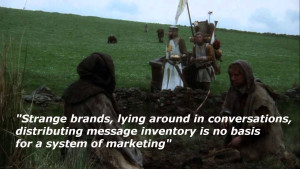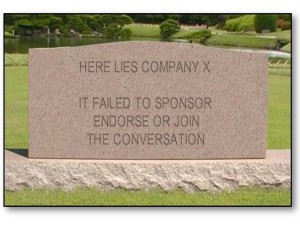Here’s the thing. In any functioning democracy there will always be a party whose primary role is to represent the interests of the rich and powerful. I don’t say this with any sense of grievance or throw-back to outdated ideas about class struggles, workers versus bosses, capital versus labour. It just stands to reason. Why would the rich and powerful not want to have their interests represented? Such a party cannot, of course, position itself as ‘The Party of The Rich and Powerful’ because if it did, it wouldn’t be elected. Instead it will have to create a story designed to persuade people that if you look after the rich and powerful, everyone will benefit.
There are two basic elements to this story. The first is the idea of trickle down: that wealth magically appears at the top and then trickles down to feed the rest of society and thus to interfere with the interests of the rich is to cut off wealth at its source, to the detriment of everyone. The second is the idea that the rich and powerful are a special breed of people, whose wealth and power has been given to them as a reward or birthright alongside a commensurate responsibility to maintain the framework of the nation and populate its institutions. This ‘Establishment’ element has more recently been expanded to encompass the super-rich who have emerged following the explosion of speculative wealth generated within the banking and financial services sector. We call these people wealth creators, which sounds much better than speculators. This label also encourages the idea that super-rich financial speculators are genuine entrepreneurs or innovators and to interfere with them through regulation or taxes will therefore risk damaging ‘the spirit of enterprise’ upon which economic prosperity depends. (Ironically, it is the dysfunctional, speculative, financial services sector that is probably the greatest inhibitor to true entrepreneurship and innovation, through its inability to provide access to capital and finance on sensible terms – as any genuine entrepreneur will tell you).
Neither of these ideas stand up to any serious analysis, but that doesn’t really matter because they serve a purpose, which is to provide a cover story. This story has the added advantage in that it can easily be incorporated into the much broader story of political conservatism. You don’t want to change the rules of the game you are winning. Keeping things the same (i.e. conserving the status quo) is therefore very much in the interests of the rich and powerful, in most instances. This is why conservative political parties are almost always the parties that the rich and powerful will adopt.
Conservatism is a good story. It has an emotional appeal that extends way beyond – and can in fact disguise – the more rational and narrow agenda of preserving wealth and power. And as we have seen recently, conservatism provides an easy route into nationalism and populism and then further into the quasi-religious territory of conspiracy and the creation of belief, based on delusion and denial of reality. Powerful stuff, as Josef Goebells was well aware.
I don’t have a problem with the rich and powerful seeking to represent their interests. It is an inevitable, possibly even a necessary part, of a functioning democracy. But the reason democracy works is because it creates a space for people to oppose the exclusive interests of the rich and powerful and thus establish a balance. The rich and powerful are still allowed to maintain a large part of their money and influence, but – to put it crudely – are prevented from taking the piss.
Neither do I have a problem with the rich and powerful trying to take the piss. I suspect it is often a necessary part of what it takes to become rich and powerful in the first place. Having a concern for the greater good of society is not usually high on the list of requirements for achieving or maintaining wealth and power. Nor should we expect it to be.
The critical concept here is one of opposition. It is very important to avoid confusing the idea of being a political party OF opposition with being a party IN opposition (i.e. not in government). A party that genuinely represents the interest of those who are not rich and powerful has an incredibly important role to play in a functioning democracy, irrespective of actually being in power. In fact a party of opposition will tend to spend more time in opposition, because it will have to contend with the soft emotional power of conservatism as well as the harder power of money and the influence money can project through ownership of the media and control of establishment institutions more generally. But this is fine because if an opposition party is doing its job properly within a functioning democracy, both in and out of power, it will provide the necessary balance and stop the rich and powerful from taking the piss.
I think that the problems we face as a society and democracy today result from the fact that for many years now, the parties of opposition have not been doing their job properly. They have confused the idea of being a party OF opposition with being a party IN opposition and elevated being in power to a primary and exclusive objective and have thus become, in no small part, either seduced by the holders of power and money or cowed by the influence these interests possess.
Why has this happened?
It has happened because of the emergence, over the last half century, of a new ideology that has never actually presented itself for democratic approval, but has instead eaten away at the functioning of democracy, both devaluing it in the eyes of much of the electorate and depriving the forces of opposition of their ability to operate.
This story, which you might call the alternative story of conservatism, really begins in 1947 with a meeting that took place at the Swiss lakeshore resort of Mont Pelerin. In attendance were economists who, at the time, were very much at the margins of economic thought. Their notional leader was the Austrian, Fredrick von Hayek and this meeting was the founding of something called The Mont Pelerin Society – which still exists to this day. The ‘thing’ of the Mont Pelerin economists was a rejection of the arbitrary and authoritarian power of the state and it’s attendant collection of unpredictable, incompetent or authoritarian players and its replacement by an international order based around the promotion of individual rights and freedoms with the messy democratic process replaced, controlled or overseen by a logical and rational framework of ‘free’ markets.
You could understand their grievance. The previous 50 years had seen two devastating global conflicts which could easily be seen as clashes between rival versions of state power. This period had also seen the emergence of socialism which, despite its initial focus on the rights and freedoms of individuals, had evolved into just another form of state-centric authoritarianism. In fact, the Mont Pellerin group were of the view that the second world war was a victory for socialism, not just in the Soviet bloc but across the west as well, where even conservative governments were now enslaved to the centralised power of the state.
It is perhaps not surprising that these ideas struggled to find a place in post-war mainstream political debate. In fact, while this ideology, which became known as economic neoliberalism, went on to become the dominant social and economic ideology of the late 20th century, it never established itself as a widely recognised ‘ism’ in the same way that socialism or capitalism did. No-one ever wore the t-shirt or waved the placard for economic neoliberalism. The reason for this is that its main supporters were some of the world’s most wealthy, and often secretive, individuals. These people saw democracy as something that was inherently threatening to their interests and should thus be controlled or side-lined, not engaged with. And these were the people who adopted and sponsored the Mont Pelerin economists and their ideology to the tune of billions of dollars. The reason they did this was their attraction to the central idea of limiting, disempowering or appropriating the powers of the state.
Think about it, if you were a billionaire industrialist or banker, the single biggest roadblock to increasing your wealth were governments that taxed you, created regulations that added costs to your business or prevented you from buying-up your competitors. Any political ideology that proposed attacking the power of government was a good thing, especially if its proposed replacement was something as intangible, ill-defined (and as easily rigged or manipulated) as ‘free’ markets.
To cut a long story short, the plan for these wealthy individuals or organisations had three elements: first pour cash into academia, such that promotion of neoliberal ideas became the only game in town worth nailing a career (or departmental budget) to. Second, establish a network of think tanks and foundations that could turn the output of academia into a platform for political lobbying. Third, enter the political sphere directly only under the cover provided by sponsorship or creation of grassroots, populist or religious movements. The Tea Party in the US was an early example, being in large part funded by donations from the Koch brothers – billionaire industrialists from Kansas.
It wasn’t really until the 1980s that neoliberalism emerged out of the academic closet and established an identity within mainstream politics. The platform for this was the Chicago Business School and its leading light, Milton Friedman. Friedman was the economic inspiration for the political revolution wrought by Ronald Reagan and Margaret Thatcher. His ‘thing’ was also never branded neoliberalism, it was initially called monetarism or supply side economics and represented a new theory about the relationship between inflation, unemployment, demand and the money supply.
At this point, the world was ready for a new theory. The 1970s had been a tough time for traditional economics. The rise of stagflation (rising inflation and unemployment) and the shocks provided by the oil crisis engineered by OPEC suggested that the old models largely based on the theories of the economist John Maynard Keynes, had run out of steam. Thatcher and Reagan were able to present themselves as leading a revolution that would re-energise moribund state-centric and bureaucratic government, invoking a new political language peppered with words like freedom, liberty, and the rights of the individual. In-so-far as there was a political strategy behind this it was crudely simple: cut taxes (especially at the top end), privatise state assets, expose public services to market forces turning what had previously been government responsibilities into profit making opportunities and reform the ‘supply side’ of the economy – code for abolishing regulations and driving down real wages (also known as improving labour market flexibility). A lightly or self-regulated ‘free’ market became the answer to almost every problem – and if there wasn’t a market solution that meant there wasn’t a problem to be solved.
And these policies worked, or at least they seemed to be working in the short-term. Economies and business practices did need invigorating. There did seem to be some truth in Thatcher’s assertion that socialism had failed working people. Deregulation, especially in the City of London, sent a wave of money washing through the economy and many parts of the economy experienced a boom, with GDP growth peaking at 5.7% in 1988.
The problem, of course, is that there were both hidden (or ignored) and longer-term consequences. The economy became de-industrialised, but without an accompanying strategy, other than ‘market forces’, to create a new source of long-term sustainable growth. The mantra of creating a flexible workforce passed as a cover story for driving down real wages and job security. The state was not actually rolled-back – it was just contracted-out. Two new classes of people emerged: on the one hand the super-rich and on the other, the working poor. By super-rich we are not (just) talking about the billionaires and oligarchs who came to London to take advantage of lax (deregulated) financial transparency, but also the fact that previously well-paid or professional work, often associated with the financial services industry, now became super-paid, bonus-inflated work, such that hitherto comfortably-off partners in accounting and legal firms could now afford to take private jets when going on holiday.
The financial services sector and the City of London are symbolic and symptomatic of the changes that the introduction of free-market neoliberalism introduced. There is a direct line that stems from the Big Bang of financial deregulation in the 1980s to the financial and economic collapse of 2008. The financial services sector no longer exists to support the creation of value in our economies, instead it has become a massive exercise in value extraction to the enormous benefit of a small number of people.
This has an extension into areas well beyond the ambit of the City or Wall Street as the example of social care in the UK illustrates. Here a toxic combination of the withdrawal of state responsibility and the intervention of financial opportunism has created a system that is clearly, to coin a popular phrase, no longer fit for purpose. Social care in the UK has not just simply been privatised or commercialised, it has been financialised, such that it has become an asset whose owners have no regard for what it is the businesses they own are charged with delivering. Numerous social care providers have been acquired by financial institutions, many overseas-owned, who can load them with debt and securitise their income streams, confident in the knowledge that government, in the form of the local authorities who now rely upon them, provide a form of income guarantee.
There are many other examples, but to summarise, the last 30 years have seen a situation emerge where the rich have, to refer back to the point made earlier, taken the piss with the financial services sector as the driving force and principal facilitator of this exercise.
Which brings us back to the question of opposition. While it was conservative governments that introduced neoliberal policies, left-of-centre, or non-conservative, governments have been in power during much of the time that this ideology established its grip. How and why did they let this happen?
There are two reasons. As noted earlier neoliberalism did not present itself as a political idea subject to transparency or democratic scrutiny. Instead it was a richly funded economic ideology that targeted and ultimately colonised academia. It therefore controlled the space where ideas and policies are first created and was able to choke-off the development of any competition. The supply of ideas to opposition parties was therefore cut off and the boundaries of what was considered acceptable debate were drawn tightly inwards into a sterile discussion about the virtues of variants of essentially the same idea. A new form of democracy was invented: free market democracy, or liberal democracy – a form of democracy that was ultimately subservient to free markets and neoliberalism. Democracy became an outcome, not a process, and to challenge this orthodoxy became tantamount to challenging the notion of democracy itself.
Second, excluded from the territory of political ideas, the parties of opposition created a new way to differentiate themselves: they created value politics. Rather than get people to vote for them based on what they were actually going to do (which was not very different from what had gone before) they sought to position themselves as being different based on who they were and what they stood for. For a time they tried to give this approach a name calling it ‘The Third Way’ albeit this had insufficient substance to last much longer than the average soundbite. They also adopted terms such as ‘pragmatic politics’ as a way of diminishing the attraction of anything that was even slightly radical or different. The concept of big political ideas was also debunked, replaced with the theory of ‘retail politics’: the assertion that people don’t want to buy big ideas, they just want to select from a range of individual policy ‘baubles’ which must be served up to them only at the last minute, with maximum fanfare, as part of a calendar of staged events designed to culminate in a general election. At all other times the strategy of opposition was to criticise the other side while spouting meaningless guff about vision and values.
Politics differentiated by values rather than substance also spawned a new approach to political management based on marketing and communications. Just as Coca Cola and Pepsi Cola have to spend big marketing dollars to convince the public that they are both very different products, the left-of-centre variant of neoliberalism created the role of the spin doctor and highly centralised and controlled messaging to promote the idea that it was significantly different from ‘nasty’ right-of-centre’ neoliberalism. Political debate also became more heated and personalised as a means of disguising the lack of fundamental substance or difference.
Right-of-centre neoliberals meanwhile promoted TINA politics (There Is No Alternative) to force acceptance that the political or ideological debate was now over and globalised free markets had won the argument. One US economist, Francis Fukuyama, even went as far as talking about the end of history.
The result was the slow death of democracy under an assault on two fronts. On the one front the neoliberal right, opposed to the very idea of the state, conducted a form of low intensity warfare against all forms of government, the public sector and the civil service. For the right, state failure became the objective in order to clear the way for the private sector and ‘the market’. The subsequent public disillusionment with politics, politicians and the state of the state simply reinforced the story. The playbook here was to make continued cuts to public service funding often in the name of creating efficiencies, thus weakening the system of universal provision, leading to increased examples of failure. Such failings were highlighted by creating targets, rankings and league tables, thus supporting a narrative of an ineffective, inefficient state – ripe for ‘invigoration’ by competition and market forces. The responsibilities of the state were then contracted out and turned into profit making opportunities for the private sector.
One the other front, the enfeeblement of the politics of opposition deprived the public of any meaningful political choice, further increasing the sense of disillusionment. “They are all the same” has become the enduring mantra. TINA politics had won. Stripped of actual political choice, democracy became simply a game about power, attracting politicians who only want to win the game. Winning is all that matters, not what happens once you have won, other than winning again.
Within the politics of the right a culture of incompetence and ‘do nothing’ government emerged. The very idea of a plan or strategy becomes demonised as interventionist, conveniently removing the need for right-wing politicians to have, or be capable of creating, any plans, policies or strategies other than to insert competition into everything and let the market sort it out. Decades of inactivity have produced a generation we could call the ‘Do Nothing Tories’: politicians with no concept of the idea that government is there to actually govern, or what governing actually means.
At the same time, the requirement to have at least some policy framework has been outsourced to think tanks and lobby groups, funded in large part by the same, often overseas-based, players who have bankrolled the neoliberal project from its inception. These think tanks and the so-called ‘dark money’ that drives them now play the same role in the nurturing of right-wing politicians that the Trades Union movement used to play for politicians of the left. The dark money interests obviously don’t want principled politicians who think for themselves and have their own ideas: in fact we have seen purges of such politicians from the parties of the right in recent years. They have been replaced by those who are dim, unprincipled and ambitious and thus sufficiently malleable. Their role is purely to take the white papers the think tanks produce and turn them into white papers for presentation to Parliament.
Almost every single cabinet minister in the (current) Liz Truss government has direct links back to such groups, having either worked for them at some point, received campaign funding from them or fronted their parliamentary representation (Liz Truss, for example, was the deputy director of Reform and founded Freer – the parliamentary wing of the Institute for Economic Affairs). Likewise the advisers to the government are almost exclusively drawn from the ranks of think tanks and lobby firms, some even remaining on the payroll of such groups while they act as ‘advisors’, including, incredibly, the Prime Minister’s current chief of staff.
At a certain point, though, problems start to emerge. This happens when it starts to become impossible to disguise the fact that the rich and powerful are taking the piss.
The 2008 global financial collapse has been a key catalyst here. Banks and free markets brought the global economy to the brink of collapse. Money that we were told was not there to support public services was none-the-less created to bail-out the banks and support the value of assets the wealthy owned. And the price for this was austerity programmes that hit the poorest in society. It was quite hard to put a positive spin on this.
Also, while economics is almost unique amongst the sciences in its refusal to challenge and thus change and adapt its fundamental assumptions, there comes a point where the total lack of evidence to support the founding claims of neoliberalism and the mounting pile of evidence demonstrating its failures (growing inequality, decline in real wages, low growth and productivity to name a few) cannot be ignored. (Note, economics’ failure to interrogate its assumptions mean it doesn’t deserve to be called a science, it has become simply a story designed to explain why it is OK for some people to have more money than others).
Neoliberalism has therefore lost much of its support within mainstream academic circles, but while it has ceased to be a mainstream economic religion, it has instead degenerated into a cult. The adults have left the room, but they have left behind the crazies, fundamentalists and also the money and the politicians dependent on it. Deprived of any evidence based credibility but also requiring someone to blame for the decades of failure, these politicians turned to a new idea: nationalist populism.
It is a cruel irony that the disillusionment created by decades of failed neoliberal policies and sometimes deliberately created to undermine trust in government and the framework of the state, is now being used to support the very people and ideas that created the crisis in the first place. We are also presented with a succession of Conservative governments, each of which positions itself mostly in opposition to the Conservative government which preceded it, rather than the actual opposition. Albeit the failure of the actual opposition makes this an inevitability: the need to create an argument to sustain the idea democracy still exists has meant that the Conservatives have had to resort to arguing amongst themselves.
There is a further irony in that the emergence of value and identity politics designed to create a space for the otherwise emasculated politics of opposition has now been turned into culture wars that both further disguise and promote the agenda of wealth and power.
In the UK, Brexit was the first and most prominent outing for nationalist populism. It is no surprise that almost all of the prominent politicians supporting Brexit were recruited from the ideological crazies or the DUA (dim, unprincipled, ambitious) brigade within the Conservative party. The Brexit campaign also saw the introduction of new forms of political campaigning, based on the promotion of false narratives that can be nurtured and spread via social media. The false narrative has since become firmly established as the principle campaigning technique for the populist right.
Now that Brexit is supposedly ‘done’ and the power of the EU as the main scapegoat thus diminished, new scapegoats are required. Hence we have the culture wars – the semi-conspiracy theory that purports that all the current wrongs of society can be attributed to something called The Establishment – a semi-secret cabal of lefty intellectuals, civil servants, lawyers and the BBC who have in fact been running the country for many years, supported by an army of ‘woke warriors’, thwarting the noble efforts of those politicians in actual government who have been struggling to promote freedom, liberty and the rights of the individual. Nonsense, obviously, but a powerful story in many quarters.
The key word here is story.
The disintermediation of media caused by the social digital revolution favours the re-emergence of storytelling. Back in the days before the printing press, the principle ‘technology’ for the spreading of information was the story. Printing turned stories into messages which could be precisely defined and controlled by those institutions or interests which had access to media. It also allowed trust to be vested within institutions – albeit institutions often owned or controlled by the wealthy and powerful. Social media undermines this trust and reduces the power of centralised messaging. We are returning to a world of Chinese whispers, where precise messages (even those we think of as facts) degrade or can become corrupted as they are retold or spun. Stories, on the other hand, don’t degrade through digital word-of-mouth.
Whilst to date this shift has been exploited primarily via the right, this could provide a lifeline for the politics of opposition. Opposition parties don’t have to tell us what precise policies they would put in place to fix social care. Instead they can tell us the story of how social care was turned into a financial asset for the benefit of wealthy people in the financial services sector.
Brexit was a story.
The populist right in the UK has a story: Britannia Unchained and Global Britain. This story (currently) says that all this great nation has to do to return to days of former glory is to free itself from the chains and burdens of regulation, taxes and the inconvenient constraints imposed on Parliamentary Sovereignty by the Constitution and the ‘enemies of the people’ who shelter behind it. Other stories may become available. Global Britain, by the way, is the Brexit version of heaven – a mythical place which the goddesses of the free market can bear us away to at some point in the future subject only to our ability to suffer a series of privations (supply side reforms) and catastrophes inflicted upon us by an ideological priesthood in Downing Street as part of period of necessary transition / purgatory.
The first story the parties of opposition need to tell is the story of what has actually happened to this country over the last 40 years. It is a story, of course, in which they are complicit and which largely serves to highlight their own failure, which may partially explain their reluctance to tell it. It should also be a story that dismisses the tired old political tropes and cliches and presents some genuinely new ideas. It should be a story that re-frames the central challenge for democracy as stopping the rich and powerful taking the piss. A story that exposes the role those currently in power, and the ideology they cleave to, has played in allowing the rich and powerful to take the piss. A story that positions Brexit, populism and the culture wars as just a cover story to allow the rich and powerful to continue to take the piss. It is a story that has to bind the problems we face to those people responsible for them – rather than continuing to allow them to shift the blame and fan the flames of nationalism and extremism.
It will not be sufficient for the parties of opposition to regain power simply because the failure of the neoliberal cult becomes so catastrophic it becomes impossible to disguise. Unless the parties of opposition establish their own story they will not have a strong enough mandate to offer a genuine alternative. A bunch of policy baubles needs a story Christmas tree to hang them on. That Christmas tree used to be socialism – but we can now recognise socialism as just another dead, white man’s ideology. Unless we have a new story we will just regress to the sterile politics of winning and the idea that simply changing the government is a sufficient alternative when in reality it is little more than changing the baubles on the same old Christmas tree.
It is time for the opposition to rediscover the politics of opposition and stop the rich and powerful taking the piss. Because that is what democracy is ultimately about.






